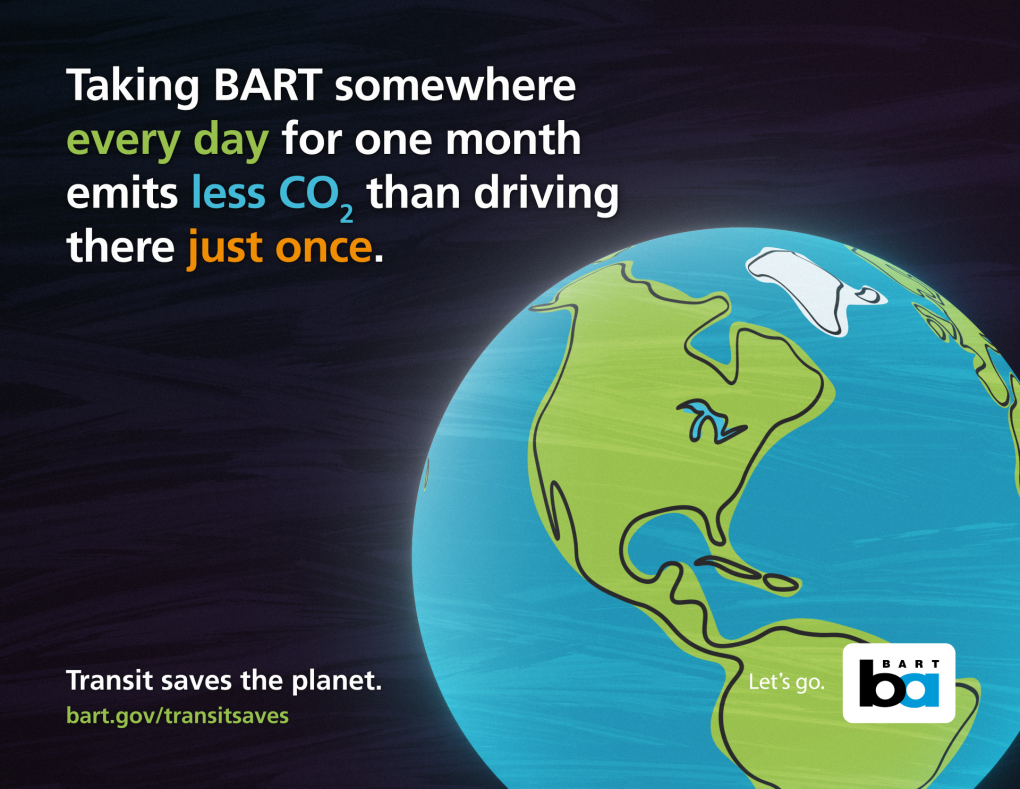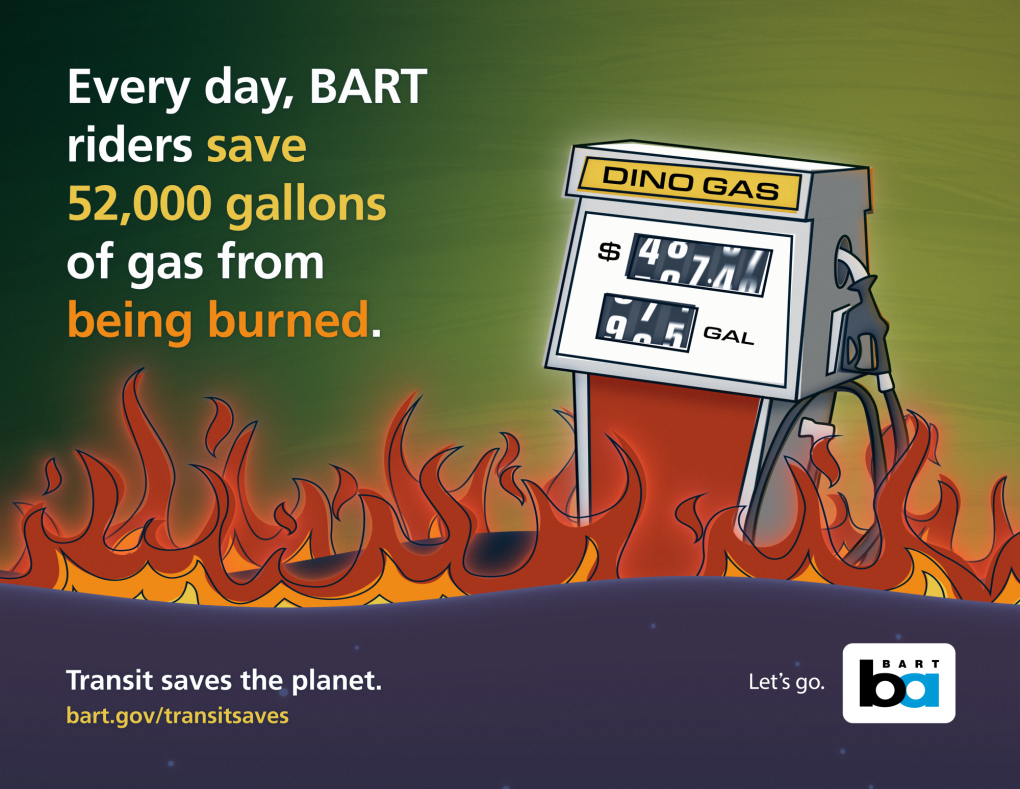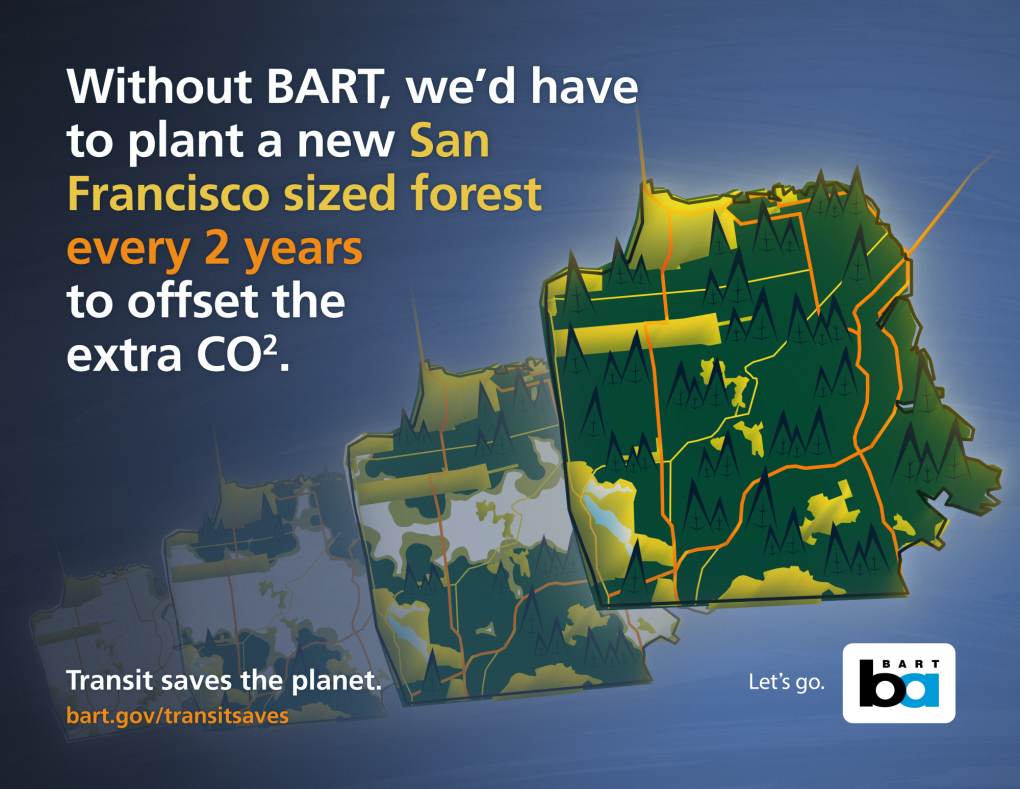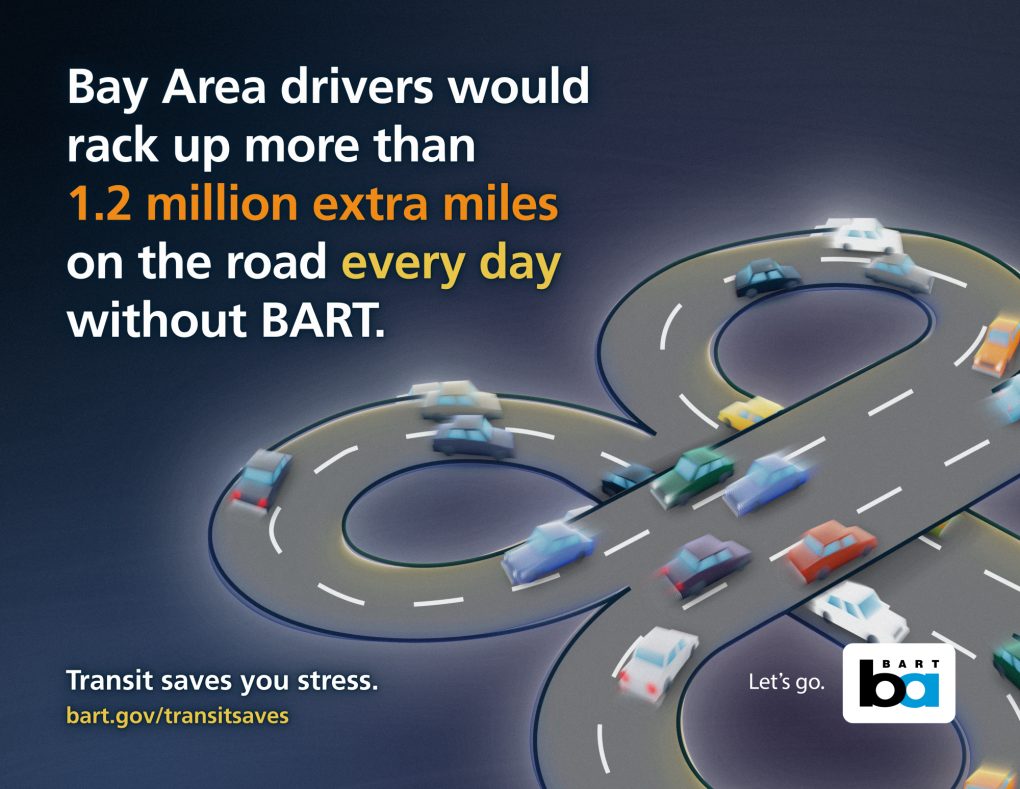Search Results
New BART system map shows minor updates for 8/2/21 service increase, easier SFO travel, Oakland representation
As BART moves ahead with its major service increase slated for Monday, August 2, BART has updated its system map with minor adjustments to better help riders plan and follow their trips as they enjoy increased service hours and frequencies on weekdays and Saturdays. In the new system map, one noticeable
Join BART's General Manager on a ride-along and happy hour with Transit CEOs on 9/29/23

In celebration of Transit Month 2023, the Bay Area transit agencies and the Metropolitan Transportation Commission (MTC) are hosting a third “All Aboard with Transit CEOs,” a ride-along and social event giving the public a chance to ride with and meet regional transit leaders. The event is also an opportunity for transit leaders to call for on-going financial support for transit operations and to showcase the coordination happening among agencies to improve the rider experience in the Bay Area.
The event is Friday, September 29, 2023, starting at 5pm at the Palo Alto Caltrain Station/Transit Center. The Palo Alto Transit Center is an intermodal transit center served by Caltrain, SamTrans, VTA, Dumbarton Express, the Stanford University Marguerite Shuttle and several local shuttle services.
Trip details:
Before 5pm: The public and Transit CEOs will come from different transit systems, connecting with the public along their route to the Palo Alto Caltrain Station/Transit Center.
5pm: The public and Transit CEOs meet at the Palo Alto Transit Center (Caltrain Northbound Platform to San Francisco) for photos and mingling.
5:19pm – Everyone boards Caltrain #709 for an onboard Happy Hour (BYOB)
5:44pm – Train arrives at Millbrae Transit Center (100 California Drive, Millbrae)
6:03pm – The Ride-a-long ends as the train arrives at San Francisco Caltrain Station (700 4th Street, San Francisco)
Members of the public and the media are invited to ride for the full or partial journey. This event is a great opportunity for the public to chat with CEOs about transit service and transit career opportunities. Follow on social media for real time updates of the CEOs journey.
Participating CEOs include: SamTrans (April Chan), Caltrain (Michelle Bouchard), VTA (Carolyn Gonot), MUNI (Jeff Tumlin), BART (Bob Powers), WETA/SF Bay Ferry (Seamus Murphy), County Connection (Bill Churchill), and LAVTA/Wheels (Christy Wegener).
The CEOs will be taking transit to the Palo Alto Caltrain Station and posting on social media using the #TransitMonth hash tag. Several CEOs will announce their routes to get to Palo Alto Transit Center if you want to join them on the journey.
BART General Manager Bob Powers will take BART's Red Line to Millbrae leaving 19th Street Station at 2:57pm and transfer to Caltrain at 4:02pm
SamTrans CEO April Chan will ride ECR leaving San Carlos Ave / El Camino Street at 4pm
Caltrain Executive Director Michelle Bouchard will ride Caltrain #410 leaving San Carlos Station at 4:48pm
VTA CEO Carolyn Gonot will ride the VTA Blue Line from River Oaks Station leaving at 3:45, changing trains at Baypointe to the 4 pm Orange Line to Mountain View. Then Caltrain #309 departing Mountain View at 4:40 pm
New exhibit at 16th St. Mission BART Plaza features woodcut prints by artist Ivy McClelland
Woodcut print by Ivy McClelland A new exhibit is opening Friday, March 20, at Public Artspace at Plaza 16, outside the 16th St. Mission BART Station. Public Artspace at Plaza 16 consists of four plexiglass-fronted bays, showcasing the work of Mission artists. This space is curated by a panel of Mission-based
Transit Saves the Planet: BART celebrates Earth Day with educational marketing campaign and collaborative community tree planting
BART's new Transit Saves 2024 campaign art is featured in the slideshow above.
Earth Day is an international event held annually on April 22 to celebrate sustainability and raise awareness about environmental protection. At BART, it is an important opportunity for us to reflect on the many challenges our planet faces, including climate change, deforestation, and environmental pollution, as well as the ways we can be part of the solution.
BART takes special care to acknowledge Earth Day every year because sustainability is a core value of our organization. On past Earth Days, we interviewed riders on trains about their carbon footprints; we created a map highlighting some of the creatures and green features around the BART system; we even put together a BART-themed Earth Day quiz.
This year, we’re celebrating Earth Day with a new educational marketing campaign that highlights some of the environmental benefits of taking BART. The campaign is now live on the digital screens in select stations and will also occupy the ad spaces in stations and trains. You can see the art in the slideshow below.
Additionally, this year BART collaborated with the Oakland Parks and Recreation Foundation and Trees for Oakland to host a tree planting event. The volunteers, which included many BART employees, planted more than 100 native trees at the Martin Luther King Jr. Regional Shoreline in Oakland.
Public transportation is one of the greenest ways to get around, and on Earth Day, BART celebrates that. Learn more about the campaign and the tree planting below.
Happy Earth Day!
BART launches second edition of Transit Saves marketing campaign

A panel from Transit Saves 2023.
Today, BART is thrilled to launch the second edition of our Transit Saves marketing campaign with three novel art concepts. We debuted Transit Saves in 2023 to highlight the many reasons public transportation enhances our communities, but there were simply too many ways “transit saves” to include in a single campaign. So, we created another one.
You can view the new art, which includes updated data from our forthcoming Role in the Region Study, in the above slideshow. As of today, you will begin to see the art around the Bay Area, including in the ad spaces on trains and in stations. Animated versions of the art will be rotating on the digital advertising screens in some BART stations as well.
Check out our Transit Saves webpage for some quick facts about BART’s importance to the region (environmentally and otherwise) and to view our methodology.
BART collaborates with local organizations for tree planting event
BART is committed to bringing the community together to safeguard our local environment.
For Earth Day, BART’s Sustainability Department organized a tree planting event at the Martin Luther King Jr. Regional Shoreline in Oakland on Saturday, April 20, in collaboration with the Oakland Parks and Recreation Foundation and Trees for Oakland. BART employees, their loved ones, BART District 4 Director Robert Raburn and his wife, Pat, and other members of the community came together to plant 100 trees, including Monterey cypress, Catalina ironwood, hollyleaf cherry, flannel bush, and various types of oak. These trees are native, climate adapted and/or shoreline adapted, and will help sequester carbon that would otherwise contribute to climate change. As you can see in the above Transit Saves art, if we didn’t have BART, we’d have to plant a San Francisco-sized forest every 2 years to offset the extra CO2 emissions. The trees we planted will also provide habitat for animal species and shade for humans and animals seeking relief from heat.
“It was such a pleasure to see everyone out here doing work that helps fight against climate change,” said BART’s Principal Sustainability Analyst, Michael Cox. “We are all public servants at BART, and we take extra pride in being able to help our community with events like this.”
Added Alex Pinto, the Community Greening Program Manager at Oakland Parks and Recreation Foundation: “I see Earth Day as an important opportunity for us to connect with nature in new ways and learn about the natural world. Putting away our electronics and placing our hands in the soil can be a relaxing and gratifying experience.”
Please join us this Earth Day by learning about the role transit plays in protecting the Bay Area and our planet. Additional information about BART's ongoing sustainability efforts can be found here. And of course, consider taking BART to your destination whenever possible!
A dream come true for a railroad history museum: The first of 3 legacy BART cars delivered to Western Railway Museum
Friday, August 9, was a thrilling and long-awaited day for the Western Railway Museum (WRM) as the railroad history museum received the first of three decommissioned legacy BART cars for its forthcoming Rapid Transit History Center.
The museum was awarded the three retired cars – an A, B, and C car – following a call for proposals in 2021 that selected eight recipients to receive decommissioned cars (two recipients later declined). BART officially retired its legacy fleet, which carried passengers for more than 50 years since the opening of the system, at a ceremony and final ride in April 2024. All 55 trains in service are now made up of new cars.
BART’s legacy cars have a tremendous sentimental value with passengers in the greater San Francisco Bay Area, and we wanted to ensure the historic vehicles would have a second life, or more accurately, second lives. The chosen six groups will reuse their cars for a multitude of purposes, including a short-term rental in the Sierras, a bike shop and clubhouse for Oakland youth, a dining car with retro arcade games, and more. The Hayward Fire Department picked up their car earlier this year for its new Regional Fire Training Center.
There was one major catch the recipients had to agree to: BART would give the cars to the groups for free, but they had to transport the cars from their temporary home at BART’s Hayward shops to their final destinations.
As you can imagine, moving a 64,000-pound BART car is not something that can be accomplished with your average trailer hitch. It requires a flatbed truck with a yellow “OVERSIZE” banner as well as a crane for getting the car off the bed. Moving just one car costs thousands of dollars.
The Western Railway Museum raised money to make sure they could get the cars to their new temporary home in Car House 3 until their proposed Rapid Transit History Center is completed. The history center will educate the public about BART and its history of innovation. In addition to the three cars, which the public will be able to enter and explore, the center will include displays, videos, a set of wheels from the front of a cab car, third rail equipment, and the antennas that enable the train to pick up power and communicate with train control. In all, the history center will celebrate the "amazing technology of the 'world's first' automated rapid transit system," said Bob Simon, a retired BART Engineering and Operations Manager who sits on the Western Railway Museum's board of directors.
"The creation and implementation of cutting-edge technologies began with BART's visionaires understanding the great challenge to design a new transit concept. They were not unlike the visionaries who went on to build Silicon Valley," he continued, offering his thanks for the support and enthusiasm of BART General Manager Bob Powers, the BART Board of Directors, and the museum's dedicated volunteers and staff.
So what does it take to move a BART car? Western Railway Museum staff found out firsthand on August 9 when they showed up to the Hayward shops with a flatbed truck and helping hands. BART employees prepared for their visit by transferring the car – #1164 – from its holding track (where the soon-to-be-decommissioned legacy cars are held) to the shop bay with a crane.
When the truck arrived from Salazar Heavy Haul – the same company that delivered BART’s Fleet of the Future cars – BART staff hooked the car up to the crane and attempted to load it on the bed. There was an unforeseen problem: The undercar equipment was just a few inches too big for the truck bed, so BART staff had to improvise by removing the battery box and HVAC underneath it. Most decommissioned cars won’t have this problem as they’ll be picked up with the wheels and mounts removed. That wouldn’t do for Western Railway Museum, however.
“They want everything on the cars so they are as authentic as possible,” explained Brian Tsukamoto, BART Manager of Special Projects – Decommissioning. “They’ll be coming back to pick up the battery box and HVAC.”
Once the temporarily modified car was loaded and secured by the highly skilled driver, it was on its way from Hayward to Suisun City up north. A sign in its front window read: “I’m going to the Western Railway Museum.”
At the museum, the team unloaded the car from the truck using a rented crane and used conversion dollies to allow the car, built for BART’s wide gauge, to be maneuvered on their standard-gauge track. Then, using a former Muni work train locomotive, they zig-zagged the car to Car House 3 and unloaded it onto the BART gauge track they built for it. To save on cutting concrete and rebar, a steel rail strap bridge was fabricated to get the car over the car house door foundation and the public walkway to its platform.
The process will soon be repeated with the B and C cars, which the museum is working to schedule with BART staff and Salazar Heavy Haul. We’ll be sharing updates.
Learn more about the Western History Museum here and the Legacy Fleet Decommissioning project here.


